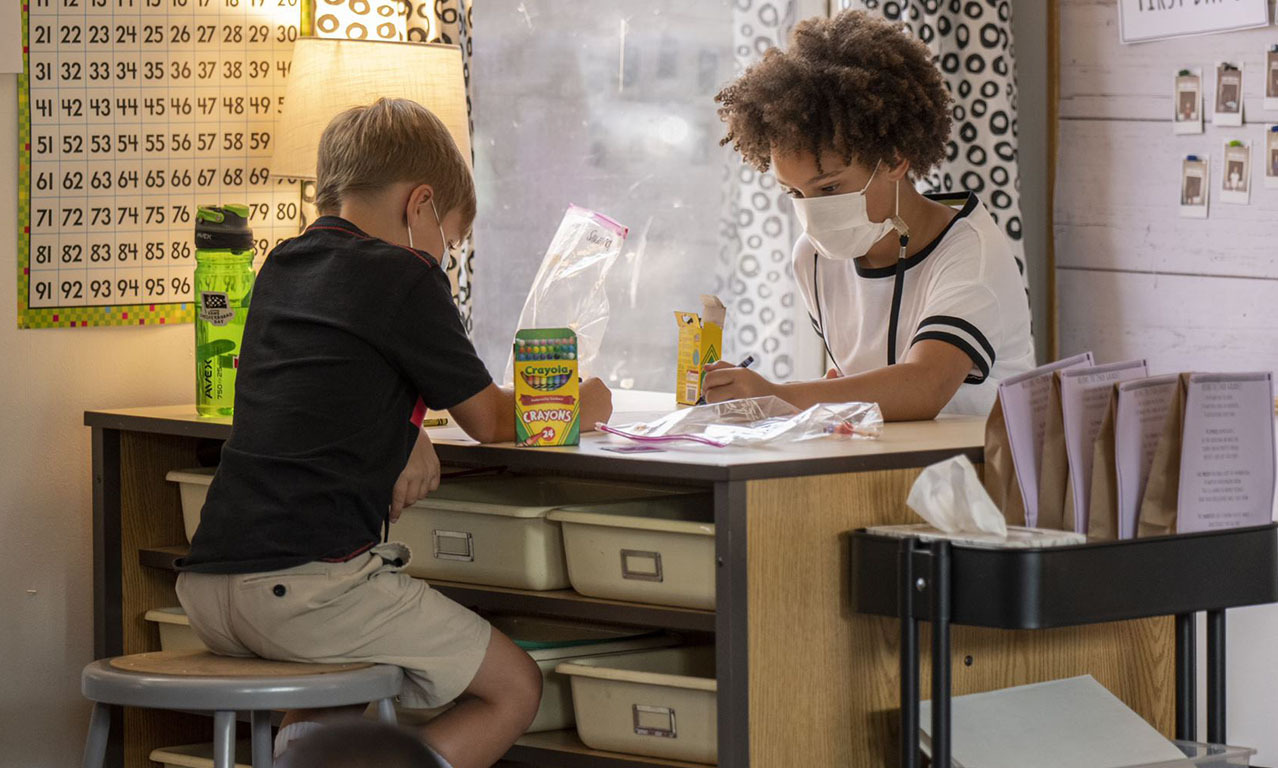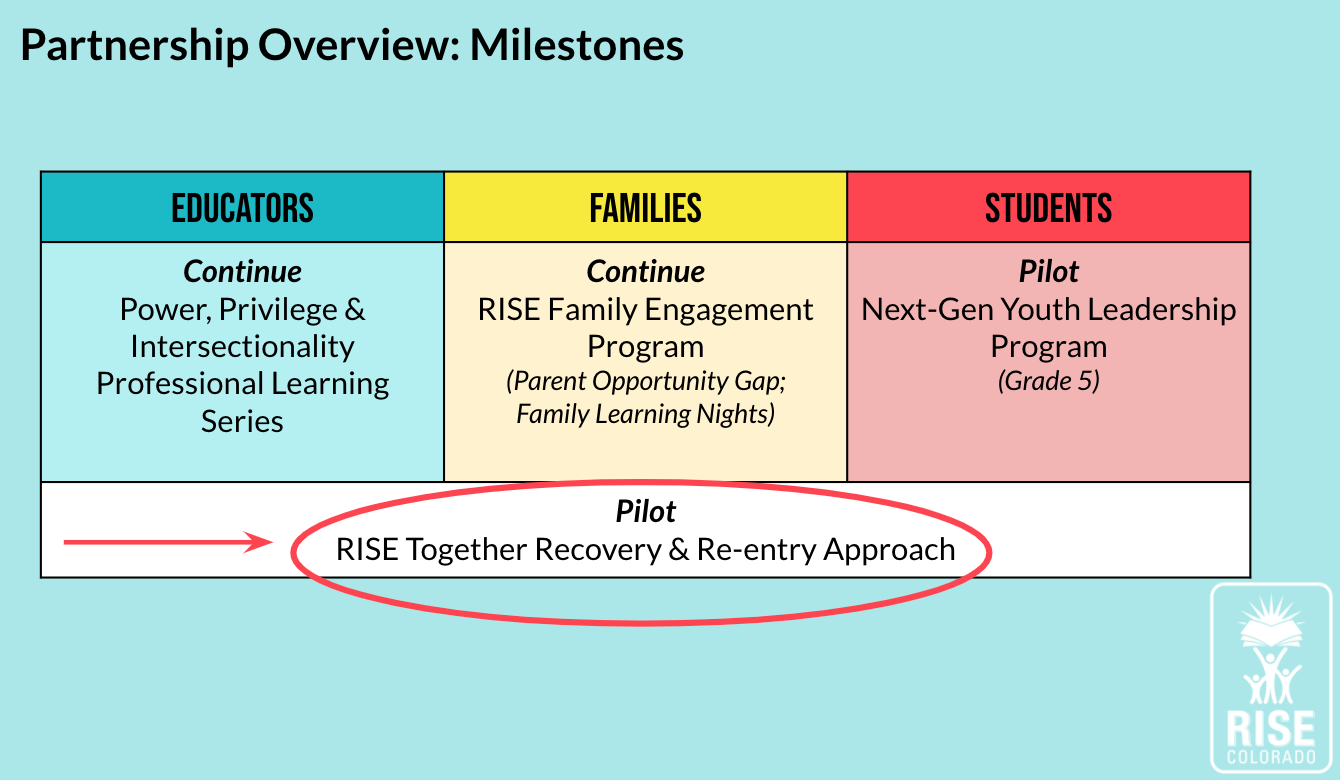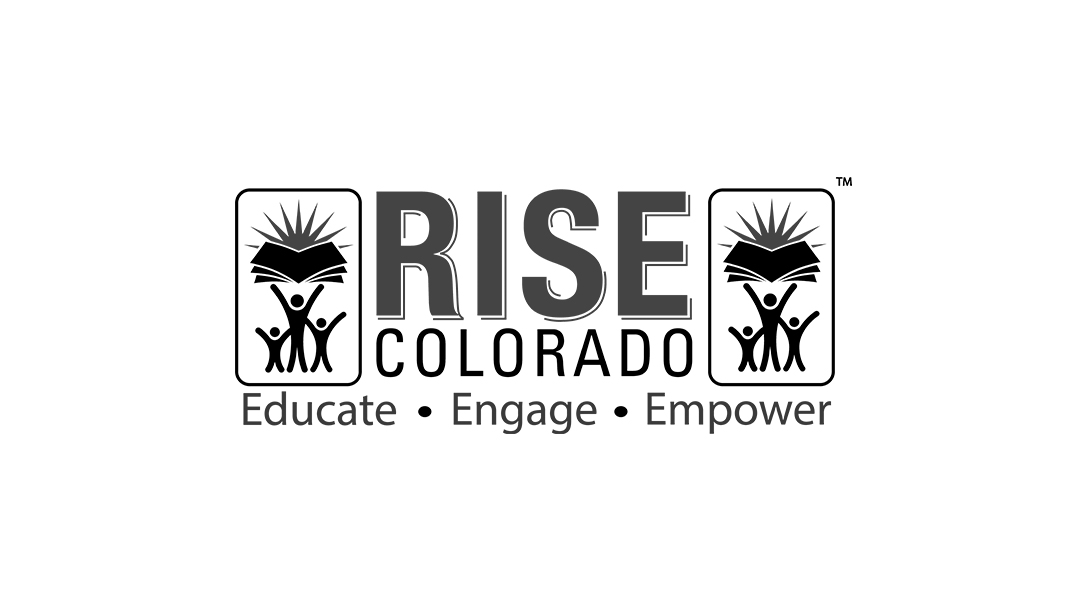Sign Up For Updates

RISE Colorado

RISE Receives Students Differently
Aurora, Colorado is an official refugee resettlement city, and the Cherry Creek School District within it, which administers Village East Elementary School, serves students from over 130 countries who speak 160 different languages. When such cultural and linguistic diversity is perceived as a deficit, it can cause families and students to feel disconnected from schools—a feeling only exacerbated by the pandemic. To combat this, the educational non-profit RISE Colorado builds relationships between families, students and schools. Their model revolves around three principles: to educate families about ending the “opportunity gap” in education; to engage families in community-led change in an effort to improve public schools; and to empower families to serve in leadership roles to work alongside local school leaders to co-create solutions for educational equity.
To achieve these principles, they rely upon structures such as affinity groups and a youth leadership program. They also elicit family and community needs through a series of one-on-one phone calls and needs assessments.
In their work with Village East Elementary—the most culturally and linguistically diverse school in the Cherry Creek School District —RISE focused on one goal in particular: connecting a school community where some families returned for in-person learning while others opted to be remote. At the end of the project, members of Village East’s school community reported a stronger sense of belonging and purpose, though the work to engage more family voices and a plan for supporting them was a work still in progress.
The Goal: Connection in a Time of Separation
The leaders at RISE Colorado described Village East principal, Mia Robinson, as having a RISE-focused mindset. Broadly, this meant a shared commitment to elevating the voices of Aurora’s marginalized communities. Mia, who identified as a Black school leader, reflected on the ways the summer of 2020—specifically, the ongoing pandemic and the nationwide protests against police violence—had affected her. She said,
“I just knew that no matter what we did, no matter what plans we had in our head, that we could not come back [to school] the same way that we were. We had to come back differently. We had to receive our kids differently.”
Bethany Owens, the assistant principal at Village East, agreed, pointing out that Village East’s work to “receive our kids differently” started even before the pandemic, but was interrupted by school closures. She recalled a district-wide initiative whereby school leaders visited each other’s campuses to listen as students voiced their views on equity and injustice. Unfortunately, the pandemic caused the initiative to be put on hold before Village East could take part, but Bethany felt confident that Village East students would have much to contribute to these conversations.
Pandemic school logistics complicated the challenge. At the beginning of the 2020-21 school year, each Village East family opted for either in-person schooling or remote learning, and they were required to adhere to that choice through the year. This created a “crisis in connectivity”where it was difficult to connect with a whole class when a portion of the class remained virtual. The phrase was used frequently as school leaders and families described what they hoped and feared about the school year. One community member expressed this feeling through an image of a container of rubber bands, titling the photo “together but not connected”.
The pandemic had caused Village East to be, in Mia’s words, “not a whole community”, and this drove an even greater need to focus on how students were received and heard. Fortunately, Mia’s clarity of purpose proved inspiring to RISE’s Director of Education, Mary Duran, who said: “I really value her thinking and her opinions and her authenticity and I try to show up in the same way.” This set the stage for the project partnership.

The project built on existing work with educators and families to create structures that would inform a school recovery plan focused on supporting mental wellbeing through a greater sense of belonging.

Key Aspects of the Project
To put Mia and Bethany’s expressed priorities into action, RISE and Village East instituted four structures to foster connectivity amongst staff, families, and students in this time of crisis:
- RISE Together Recovery & Re-Entry Approach. RISE guided a group of Village East staff as they designed a survey for families and staff. The survey addressed feelings of connectedness, belonging, and being valued. The Village East team generated and revised survey questions and made the conscious decision to include more participants, specifically by using established school meeting time to include para-professionals and custodial staff, and leveraging translation resources to reach multilingual families in Aurora’s immigrant community. Questions included open-ended items such as, “What does belonging mean to you?” and “What does connection mean to you?”; fill-in-the-blank sentences such as “I feel connected when______”; and Likert scale questions about feelings of connectedness to certain aspects of school.
- Next-Gen Youth Leadership Program. As part of a pilot program that sought to engage students in the decision-making process at Village East, a small group of 5th grade students helped craft a survey to be administered to their peers. Some questions were borrowed from the staff design session, but RISE facilitators accommodated 5th graders’ suggestions to include items on cyber bullying and confidence-building. The 5th graders also suggested that the survey include K-2 students, rather than be exclusive to upper elementary grades. As a result, RISE and Village East took steps to develop a new survey geared toward early elementary school children.
- RISE Family Engagement Program. Two types of events were offered as part of this program: Parent Opportunity Gap (POG) Nights and Family Learning Nights (FLNs). POG Nights engaged Village East families in conversations about the opportunity gap in American schooling, defined as the disparity in access to quality schools many students experience. FLNs extended the conversations began at POG Nights, offering families guidance in supporting their children as learners. Village East teachers planned and led all family engagement events alongside their grade-level colleagues. In one session for 4th and 5th grade families, parents who had chosen remote learning for the year were taught how to reinforce literacy skills in alignment with the support teachers offered to in-person students. Village East staff recorded a significant increase in parent participation between their first POG Night and the subsequent FLN: while 145 families logged on for the POG Night, 201 families signed up for the FLN. Village East leaders attributed this to the eye-opening nature of the opportunity gap conversations, which motivated participation in the FLNs.
- Power, Privilege, and Intersectionality Learning Series. RISE helped coordinate monthly racial consciousness training for Village East staff. These training sessions centered on a “Story of Self, Story of Us, and Story of Now” reflection exercise. Mia recognized how transformative these sessions were for her staff, so she invited Village East parents to share writing about their own stories of self. Mia also acknowledged how RISE’s support with these sessions allowed her to focus her mental energy on the heaviness of the conversations taking place, allowing her “more capacity to lean into it.”
Impact: Creative Connections
At one of their student leadership sessions, a small group of 5th graders gathered with Mia and their teacher in a conference room at Village East. RISE facilitators conducted the session remotely, and as they concluded, they asked the students if they had any questions. One 5th grader, curious about the status of the student leadership team, asked if the group gathered in the room would be the same group of youth leaders going forward?
“Yes,” replied the RISE facilitator, adding that they intended to invite an additional ten students to the program. In fact, the 5th graders would help select the new members.
“Will we meet in another room?” asked the 5th grader. A pause occurred, so the 5th grader continued: “Because I was thinking, how would we 3-feet-apart this [sic]? It’s a pretty small room!”
This exchange was one of many in which the priorities expressed by RISE and Village East leaders played out. Young students took the recovery work seriously and were taken seriously in the process. By positioning these students as active participants in their school’s reopening plan, it created space for this type of invaluable student candor. This indicated progress toward Mia’s expressed hope that this year the school would be receiving kids differently.
Such relational trust requires hard work. In their discussion facilitation, RISE facilitators and Village East leaders were careful to establish trust through culture-building invitations (“Describe a moment when you felt like you belonged, as well as a moment when you felt like you didn’t belong.”). Facilitators also frequently invited those who were typically silent to speak, and re-voiced what they heard so that others might respond. In another interaction with the 5th graders, RISE facilitators noticed that multiple students kept referring to the survey as a “test”. They paused the group and inquired about the repeated use of the word test. It opened up a conversation about how some students felt that surveys expected certain responses. This, in turn, lent itself to a conversation about the way the survey should be administered—perhaps not as a required, pencil-and-paper exercise—but as something offered as an option by a trusted adult.
In addition to children’s insights highlighted by this project, parents felt heard too. One parent remarked on what it was like to be invited to the Story of Self exercise, contrasting this with her experiences in her home country:
“I came from a background where everyone looks like everyone…It’s easy to think that everyone thinks like you. Everyone has the same point of view, hopes and worries, but it’s not true…So the first time I participated in a RISE meeting, they were encouraging us to write a story of us. And when I heard the other people’s stories and when I had the chance to tell my story, I felt included. I felt a part of a bigger community because you felt the connection between you and others’ hopes and worries and lives and stories. If you don’t feel included you can’t really succeed in any part of it.”

RISE has laid down important foundations at Village East, something Assistant Principal Owens captured in a photograph of Legos blocks she entitled “Creative Connections”. She elaborated: “I feel like with the surveys, with the family learning nights, those are all building blocks. They’ve all started this foundation of something. It’s not fully built and there’s so many different pieces. But we’re onto something and we’re not going to quit…It’s only going to get better and bigger and stronger.”
Ongoing Work
At the end of the project, RISE and Village East were continuing their work of designing alternative ways of eliciting family’s voices. They are also in the process of designing, then implementing a re-entry plan that incorporates feedback from all the voices at Village East Elementary School.
For more information about RISE’s pandemic recovery efforts as they relate to the city of Aurora as a whole, please see their recently published report, “Our Stories. Our Time”.
MORE CASE STUDIES:
Jun 3, 2021


Visit
rise-colorado.orgHighlights
We use cookies to help us improve the site and to inform our marketing and digital content efforts. If you choose ‘Don’t Enable,’ sites you’re logged into – like Facebook and Twitter – may still be able to identify you as a visitor to this site. Learn more.


